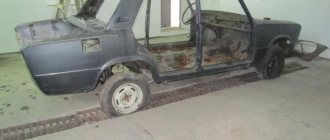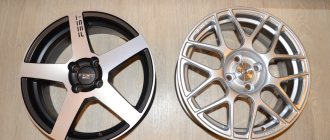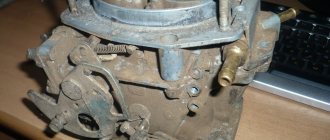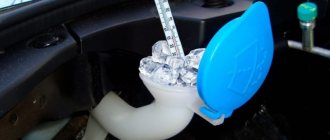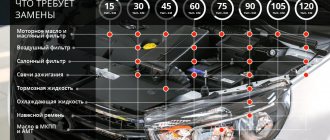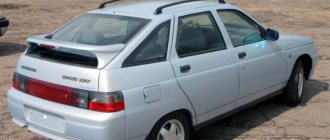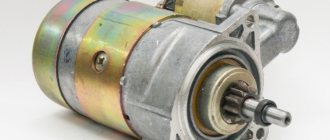Composition, characteristics and principle of action of Movil
The abbreviation “MoVil” was formed from the names of the cities (Moscow and Vilnius) in which this anti-corrosion composition was first created. Now Movil is not a specific product, but a whole direction in the production of anti-rust products, which are produced by various companies in Russia and the CIS countries.
Movil is understood as a universal anticorrosive agent in the form of a liquid, spray, paste of black or dark brown color, intended for treating the body and hidden cavities of the car. The product will also help keep the elements of the machine intact and protect them from rust if it has to be preserved.
The composition of the product is quite complex. It is represented by the following ingredients:
- white spirit solvent;
- paraffin;
- zinc;
- machine oil;
- calcium sulfonate;
- kerosene;
- drying oil;
- modifying additives;
- corrosion inhibitors;
- thixotropic substances;
- additives for displacing moisture;
- deodorizing components.
Movil is suitable for any base materials, fits well on painted and unpainted surfaces, and does not require prior removal of bitumen or mastic insulation. The product is incompatible only with synthetic mastics - the latter become loose and peel off from the base. Rubber products also react poorly to Movil - the composition can damage them.
Thanks to thixotropy, the product quickly flows into the smallest cracks and microscopic chips, fills them and creates an active anti-corrosion film. A thin oily layer prevents the formation of rust, isolating the metal from moisture, air, and aggressive chemicals that cause corrosion. Movil works as a rust converter, eliminating already formed foci due to the presence of special additives.
Different brands of Movili may differ in density, freezing point, and other indicators, but for most products the technical characteristics are close to the following:
- spreadability on metal – up to 10 mm;
- share of volatile substances – up to 57%;
- density – 840–860 kg/sq. m;
- time until complete drying - about 120 minutes;
- corrosion resistance in sea water – 99%.
For what surfaces is Movil anticorrosive agent intended?
Movil with a rust converter can be used on any metal substrates. They are allowed to work on corrosion, as well as on undamaged metal, painted and varnished surfaces. Most often, car owners prefer to use the composition for treating closed cavities and complex elements:
- front roof pillars - condensation accumulates on them, which over time causes rust;
- thresholds - the presence of holes on the parts provokes the penetration of moisture;
- hidden cavities in the trunk - felt can accumulate water, which increases the risk of corrosion;
- the inner surface of the doors - condensation, dirt appears here constantly;
- areas where seals are attached - moisture regularly accumulates under the sealing elements and causes rusting of the metal.
There is no point in applying Movil to the underbody, wheel arches, or open body parts - it cannot boast of high mechanical strength (with the exception of special high-strength Movil). Also, due to the strong chemical odor associated with the presence of solvent, the product should not be used inside the car. It is forbidden to spray Movil on rubberized parts, as well as surfaces on which there is a layer of synthetic mastic.
What is Movil? Varieties of Moville
Traditional anticorrosive for cars contains the following ingredients:
- drying oil;
- machine oil;
- anti-corrosion compounds.
If the anti-corrosion agent does not contain these substances, it cannot be called Movil.
The original drug Movil for cars was developed by specialists from research institutes in Moscow and Vilnius. The word was formed from the first letters of the names of these settlements.
This substance appeared on the market in the last century. However, it still remains popular in the Russian market of anti-corrosion compounds, because has a low price and good quality. Therefore, many vehicle owners realized that such a product allows them to protect the body from rust and also save a lot.
There are 3 varieties of this anticorrosive:
- pastes;
- liquids;
- aerosols.
Aerosol products are the most popular because... they are extremely convenient to use. The cost of 1 can of 520 ml of aerosol varies from 190 to 350 rubles. Among the disadvantages of this product, consumers note only that the can must be held vertically when working. However, there are aerosols that are sold with a special tube sprayer.
Movil in the form of a solution is a more budget-friendly option for treating the body against corrosion. The price of 1 canister with 3 liters of solution ranges from 290 to 420 rubles. The liquid substance allows you to treat hard-to-reach areas. The composition is easily applied to the inner surfaces of car doors and thresholds. To achieve the most even distribution of the drug, you can use a grinder with a ball attachment.
The paste-like product is sold in plastic or tin cans. The price of this product starts from 180 rubles. per jar of 860 g. The substance is applied to the desired places using a brush.
How to choose a product
The choice of Movils on the market is extensive, there are products in a can and paste, liquid in cans and on tap. The shape of the product is selected depending on the application area. If you plan to treat hard-to-reach places, you should buy an aerosol with a special long nozzle (flexible tube). The bottling product requires a special gun for Moville - the composition is filled into such a device, after which it will be convenient for them to process even large surfaces.
According to reviews from car enthusiasts, Movili produced in Moscow and St. Petersburg are of the highest quality, and products from Lithuania are usually less effective in operation.
Also in stores there are so-called long-drying Movili, which have higher elasticity, are thick, and create a durable protective layer that does not react to mechanical damage.
How to use Movil
The composition can be applied to metal that has been cleaned to a “bare” appearance, as well as to a painted and primed base. In the cold season, it is better not to use the product - the effectiveness of the treatment drops already at +10 degrees. If the weather is too hot (above +40 degrees), Movil is also not used, so the best time to work with it is late summer, spring, early autumn. To avoid damage to rubber parts, they must be removed or securely closed in advance.
Preparing the car
Areas of future treatment with Movil must be properly prepared. They are cleaned from dust and dirt, and a portable car wash with a water jet pressure of 60–100 atmospheres is best suited for this purpose. If the product is to be applied to the bottom, the car is washed on a lift. To remove oil stains and petrochemical deposits, special detergents are used.
When a car part is already covered with a thick layer of rust, the latter needs to be cleaned with sandpaper or a grinding machine. This point especially applies to loose rust, which after treatment with Movil will immediately begin to flake off. The same rule applies to cracked paint. Immediately before work, the surface is dried in the open air or by force (for example, by connecting a compressor). Deep chips and holes in the metal are repaired with auto putty before applying anticorrosive.
How to dilute Movil
The composition with zinc and corrosion inhibitors in the form of an aerosol is sold in finished form, and it cannot be diluted, and it should not be. The same rule applies to liquids in jars and canisters: adding solvents and other substances will increase the fluidity of the composition, while reducing its quality. Of course, when adding white spirit or solvent, the product will dry even faster, but the strength characteristics of the film will greatly decrease. At the slightest impact, the formed coating will tear due to poor surface tension.
Paste-like Movils sometimes thicken too much and require dilution, otherwise they are quite difficult to apply. You should not use solvents: it is better to slightly heat the composition in a water bath to make it more liquid. Gentle heating is allowed as many times as required.
How to apply Movil
It is important to apply the product in an even layer, the thickness of which after drying will be 40–60 microns. Movil consumption in this case will be approximately 400 g per square meter of surface. The product is most effective when applied in several layers (usually 2-3).
Movil is sprayed onto the base from a cylinder with a long thin nozzle or worked using a pistol. Since application is carried out under pressure, the active composition penetrates into all crevices, cracks and hard-to-reach places. It is better to apply Movil with a brush to open areas and large areas. The intermediate drying time of the layers should be observed (20–30 minutes), as well as the period until Movil is completely dry (2 hours or according to the manufacturer’s recommendations).
Tips for working with anticorrosive agents are as follows:
- Before you start, you should apply the product to the trunk or door to see how it spreads - in the future you can navigate by the most comfortable method of spraying and approximate consumption;
- if the composition gets on the paintwork, it must be wiped off immediately with a soft cloth - this will be difficult to do later;
- after using Movil, a pungent odor often remains in the car, which can be removed only by leaving the car windows open for at least a couple of hours a day (at first);
- if airing the car does not help in getting rid of the “odor”, you can use carbon odor absorbers;
- The ideal option is not to use the machine for 2–4 days after applying the coating, and only then allow it to be used.
Treatment of hidden cavities
To process the internal cavities of the machine, first dismantle all elements that are removable and can interfere with the work process. If this is possible and there are drainage holes, they are washed and dried with a stream of warm air. If there is old rust, it is removed with a converter and washed with an alkaline solution. Next, attach the nozzle tube to the can, insert it into the cavity and spray Movil.
Bottom treatment with Movil
The bottom must be treated with especially strong compounds, because it is subject to strong mechanical loads. Typically, this body element undergoes anti-corrosion treatment at the factory, but as aggressive factors influence, the protection weakens. In this case, the work should be repeated, choosing long-drying Movil.
The procedure is as follows:
- wash the car, put it on a pit or overpass;
- clean the metal to a shine in places where there is already rust;
- remove swelling, deposits, rotten holes, and weld, cutting off all damaged areas in advance with a grinder;
- prime the metal;
- dismantle elements that interfere with work;
- turn off the fuel supply valve to the system, acting especially carefully if there is gas equipment;
- dry the bottom well with warm air;
- apply Movil in 2–3 layers using a brush using airless spraying;
- dry for 2 hours;
- Reassemble the car, attaching all the removed parts.
Threshold processing
Applying anticorrosive to thresholds is a labor-intensive task, but it is necessary to prevent the development of corrosion. To begin with, perform partial disassembly of the interior, removing all plastic elements. When removing the pads, you need to be careful with the clips and latches - if they are broken, the elements will rattle a lot when driving. Then you need to do the following:
- unscrew the sound insulation;
- find ready-made holes or drill them along the outer part of the thresholds (the second method is not advisable);
- apply Movil from a spray can, inserting a thin nozzle directly into the hole;
- press the sprayer, fill the walls of the thresholds with Movil (use at least 1/3 of the can for each);
- Allow the product to dry completely;
- Cover the drilled holes with rubber inserts (buy them separately at a car store).
Door processing
Usually doors start to rust from the bottom side. If elements of corrosion appear on them, you need to clean the area, prime it, paint it, and only then treat it with Movil. The holes are welded or sealed with auto putty, although the second method is short-lived. Then remove the window handles, unscrew the mounting screws and bolts, remove the latches, and remove the door cards. If wires enter them, carefully disconnect them, recording the correct connection. Afterwards you can wash the door, dry it and apply Movil. As it dries, all removed elements should be returned to their place.
Arch processing
To apply the product to the arches, first remove the wheel arch liners by unscrewing the screws with a Phillips screwdriver. Then the arches are washed and cleaned well, dried and anticorrosive is applied in the standard manner. In order to easily unscrew the screws in the future, you can treat the place where the bolts are screwed in with machine oil.
Technology: how to use Movil solution to protect cars and precautions
To complete the work, it is important to select the consistency of the mixture by adding a solvent. It must be remembered that the fluidity of the solution depends on the ambient temperature; 20°C is considered optimal. The treatment procedure using an aerosol looks much simpler, because the mixture is already in working condition.
Treatment of easily accessible areas
For those who are interested in how to use Movil anticorrosive for cars in easily accessible places, you should familiarize yourself with the following points:
- Prepare the surface by removing dirt and loose layers of oxides.
- Degrease the work area and dry it.
- Apply the first layer of anticorrosive with a roller or brush. If an aerosol is used, the can should be shaken several times beforehand. The solution is fed through the spray head.
- Dry and apply a second and, if necessary, a third layer with intermediate drying.
- The coating dries completely within 24 hours; it is not advisable to operate the car during this period.
Important! If preservative gets on the surface of the paintwork, it must be quickly wiped off with a cleaner for bitumen stains.
Treatment of hidden cavities
The operation has its own characteristics and proceeds according to the following scheme:
- Remove elements that interfere with the work process.
- If there are drainage holes, rinse the cavities thoroughly.
- Treat the cavity with a rust converter and rinse after a while using an alkaline reagent.
- Dry the closed cavity with a stream of warm air.
- Connect the flexible tube from the kit to the cylinder; if the cylinder is designed to work with a gun, then install it in its regular place.
- Insert the end of the tube or gun into the technological hole and spray the anticorrosive agent.
For processing car body treatment with Movil, sprayers with a working pressure of 3-11 MPa (for airless spraying) or 2-4 atmospheres for air application are suitable.
Precautionary measures
You should work with Movil in the fresh air, since its fumes are toxic. If it is applied in a garage, it is important to ensure good ventilation, otherwise the health consequences will be serious. Be sure to wear a respirator, goggles, gloves and avoid contact of Movil with skin. The product is highly flammable, and you need to work with it away from sources of heat and fire!
If you regularly inspect the car, assess its condition and carry out anti-corrosion treatments, the parts will last an order of magnitude longer. To combat rust, you should use Movil, which boasts affordability and excellent quality.
Which Movil to choose. Wealth of offers on the market
The most popular manufacturers of anti-corrosion products in the modern auto chemical market:
- Astrochem. This company produces Movil aerosol Antiruster. The popularity of the product is explained by its high quality, affordable price and effectiveness.
- Eltrans. This manufacturer offers consumers an effective anti-corrosion aerosol.
- AGAT-AUTO. The company produces the autopreservative Movil in the form of an aerosol with an effective corrosion converter.
- Development of PKF. The company produces HH MasterWax in the form of an aerosol or solution.

